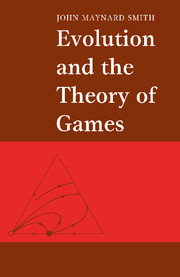Book contents
- Frontmatter
- Contents
- Preface
- 1 Introduction
- 2 The basic model
- 3 The war of attrition
- 4 Games with genetic models
- 5 Learning the ESS
- 6 Mixed strategies – I. A classification of mechanisms
- 7 Mixed strategies – II. Examples
- 8 Asymmetric games – I. Ownership
- 9 Asymmetric games – II. A classification, and some illustrative examples
- 10 Asymmetric games – III. Sex and generation games
- 11 Life history strategies and the size game
- 12 Honesty, bargaining and commitment
- 13 The evolution of cooperation
- 14 Postscript
- Appendixes
- Explanation of main terms
- References
- Subject index
- Author index
5 - Learning the ESS
Published online by Cambridge University Press: 05 June 2012
- Frontmatter
- Contents
- Preface
- 1 Introduction
- 2 The basic model
- 3 The war of attrition
- 4 Games with genetic models
- 5 Learning the ESS
- 6 Mixed strategies – I. A classification of mechanisms
- 7 Mixed strategies – II. Examples
- 8 Asymmetric games – I. Ownership
- 9 Asymmetric games – II. A classification, and some illustrative examples
- 10 Asymmetric games – III. Sex and generation games
- 11 Life history strategies and the size game
- 12 Honesty, bargaining and commitment
- 13 The evolution of cooperation
- 14 Postscript
- Appendixes
- Explanation of main terms
- References
- Subject index
- Author index
Summary
Dawkins (1980) has emphasised the analogy between ESS's on the one hand, and ‘developmental stable strategies’ (DSS's) and ‘Culturally stable strategies’ (CSS's) on the other. The idea behind a CSS is simply that the connection between generations may be cultural rather than genetic: children learn what to do from their parents, or other members of the previous generation, instead of inheriting genes which determine their behaviour. Cultural inheritance has been analysed formally by Feldman & Cavalli-Sforza (1976) and by Lumsden & Wilson (1981); it is considered from a game-theoretic point of view in Chapter 13. This chapter is concerned with developmentally stable strategies, in which the analogue of genetic inheritance is learning, not cultural transmission.
The example which Dawkins uses to illustrate the idea of a DSS is so apt that I cannot resist borrowing it. Baldwin & Meese (1979) studied the behaviour of a pair of pigs in a Skinner box, arranged so that when a lever at one end of the box was pressed, food was dispensed at the other. They found that in those cases in which the pair developed a stable pattern of behaviour, the dominant pig pressed the bar and then rushed over to the food dispenser, while the subordinate pig waited at the dispenser. Such behaviour is stable for the following reason. Provided that enough food is dispensed at each press of the bar to ensure that some is left when the dominant pig arrives, the dominant is rewarded for bar-pressing; obviously, the subordinate is rewarded for waiting at the dispenser.
- Type
- Chapter
- Information
- Evolution and the Theory of Games , pp. 54 - 67Publisher: Cambridge University PressPrint publication year: 1982



